Successful expectations.
The expectations of success of
SAESC for metropolitan areas of the country are based on:
- The structuring of a network of Food Logistics Centers that meet the demand of the metropolitan areas of the country. FEDEAGRU DE COLOMBIA with the SAESC brand will attend the sale with a national and international demand in annual tons of the products harvested by the farmers to be consumed and distributed to the populations of the interior metropolitan areas and from outside the country.
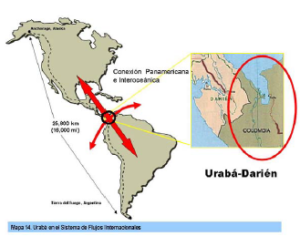
- The possibility that the wholesale merchants will cover that demand constantly for the orders that SAESC will raise in their daily journey, is an extremely attractive sales force for the wholesale merchants, since it will be linked the marketing of products directly with the field.
- The attraction for the final consumers of the metropolitan areas, is the saving of supply costs incurred by the outsourcing of intermediaries in the commercialization chain, when they buy directly from the farmers. There will be financing policy in which another attraction is constituted, since they will enjoy credit, will be subject to the credit study.
Urabá in the system of international and national flows
The Urabá Darién region presents privileged conditions for connectivity at national and international levels, due to its strategic position in the corner of the South American continent, whose use could eventually position Urabá as a high-value transport node at national and international levels.

The Vision of Antioquia as “The Best Corner of America” is based on the privileged location of Urabá, due to its corner condition, which offers opportunities for continental and interoceanic connections, and the possibility of providing port services given the favorable conditions of the Gulf from Urabá for the establishment of a port, closer to the country’s major consumption centers.
The Urabá region enjoys exceptional conditions for the maritime and river connection, thanks to the Gulf of Urabá and the presence of rivers that, due to their flow and conditions, allow navigability. Conditions that have not yet been exploited as a key factor in the development of Urabá and Antioquia.
- The Leon River that is part of the gear of elements that together make up the port activity of the banana economy.
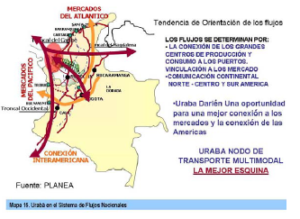
- The canals and piers of Zungo and Nueva Colonia that are part of the same port system for the marketing of bananas
- Turbo’s cabotage port that provides the service for the transport of bulk goods to nearby centers, and passengers for the Chocó tourist centers located on the western gulf side.
Banana production is partly oriented to export, the other products to the local market and the Atlantic coast. There is practically no exchange of goods with the central area of Urabá, which has the greatest economic dynamics and demand for products due to the concentration of population in the conurbation of the banana axis.
Extensive livestock, which is developed in large estates, in the flat areas with little slope of the valleys.
Peasant economy in small plots developed on the coastal plain of the municipalities of the Urabá region and on the upper parts of the river basins the most representative products of small
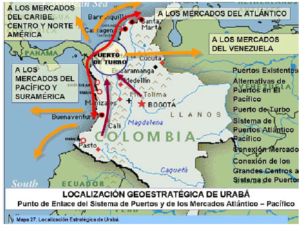
Producers is (banana, cassava, corn, cocoa palm, pineapple, passion fruit)
The small producers have been displaced by the expansion of the large estates and but the biggest displacer of the peasants has been the armed conflict that our territories have lived since the 1980s.
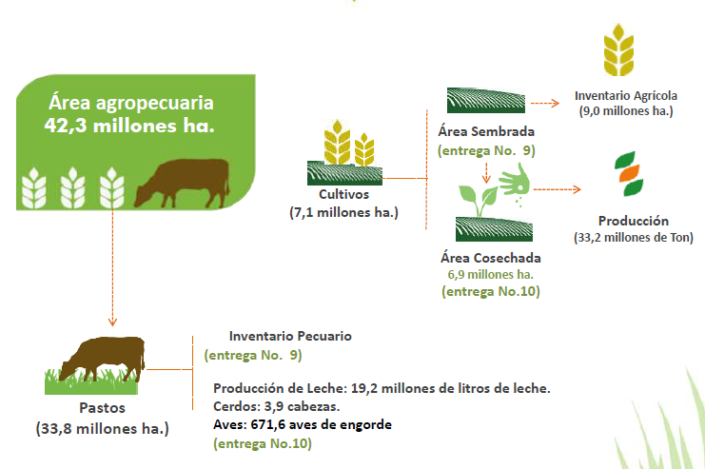


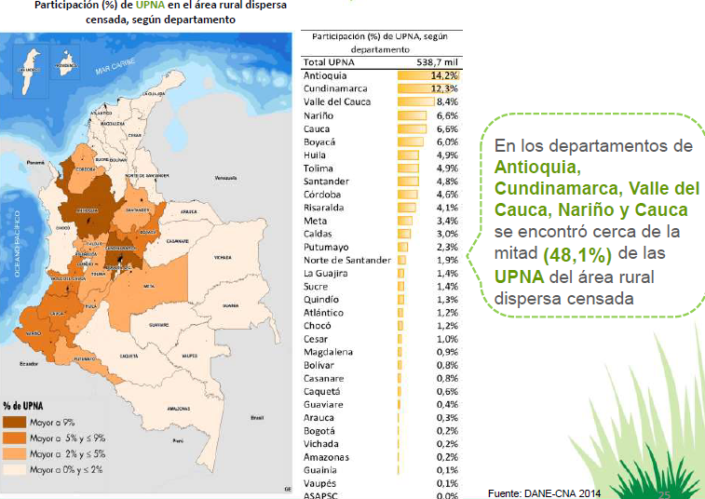
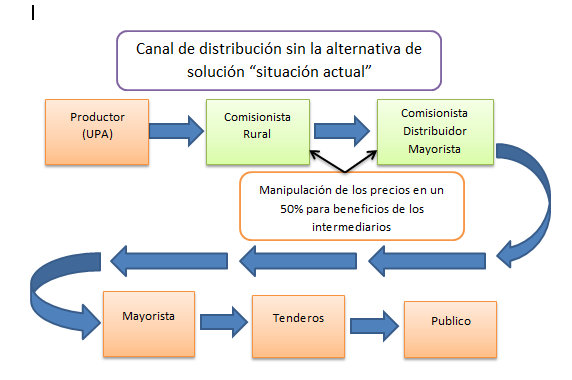
 FEDEAGRU EN LA REGION DE URABÁ, (Chigorodó)
FEDEAGRU EN LA REGION DE URABÁ, (Chigorodó)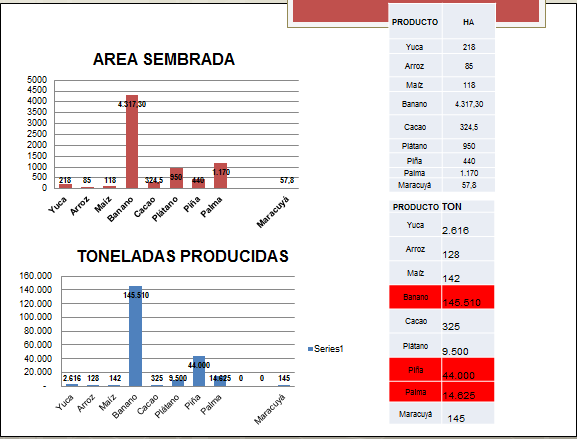 The production in tons of Rice in the municipality is 128 tons in 2014 generating 0.40 jobs per hectare with an area planted 85 hectares creating a total of 34 jobs for the total hectares planted in the town.
Production in tons of Corn in the municipality is 142 tons in 2014 generating 0.20 jobs per hectare with an area planted 118 hectares creating a total of 24 jobs for the total hectares planted in the town.
Production in tons of Cocoa in the municipality is 32 tons in 2014 generating 0.50 jobs per hectare with an area planted 324 hectares creating a total of 180 jobs for the total hectares planted in the town.
Production in tons of Banana in the municipality is 9,500 tons in 2014 generating 0.80 jobs per hectare with an area planted 950 hectares creating a total of 760 jobs for the total hectares planted in the town.
Production in tons of Maracuyá in the municipality is 145 tons in 2014 generating 0.80 jobs per hectare with an area planted 57.8 hectares creating a total of 72.25 jobs for the total of hectares planted in the municipality. The total tons produced for the year 2014 in the agricultural products described above were 12,563 tons with an average of sown hectares of 2,273 hectares and with a generation of employment of 1150 direct employment. For these reasons, a more direct distribution channel with the SAESC brand is necessary so that small agricultural producers can access the direct sales marketing markets of their products and maintain a sustainable and safe economy In their communities. Most of the tons produced are subject to intermediaries for the benefit of their capitals, making the excuse that prices fell because the market is demanding it.
The production in tons of Rice in the municipality is 128 tons in 2014 generating 0.40 jobs per hectare with an area planted 85 hectares creating a total of 34 jobs for the total hectares planted in the town.
Production in tons of Corn in the municipality is 142 tons in 2014 generating 0.20 jobs per hectare with an area planted 118 hectares creating a total of 24 jobs for the total hectares planted in the town.
Production in tons of Cocoa in the municipality is 32 tons in 2014 generating 0.50 jobs per hectare with an area planted 324 hectares creating a total of 180 jobs for the total hectares planted in the town.
Production in tons of Banana in the municipality is 9,500 tons in 2014 generating 0.80 jobs per hectare with an area planted 950 hectares creating a total of 760 jobs for the total hectares planted in the town.
Production in tons of Maracuyá in the municipality is 145 tons in 2014 generating 0.80 jobs per hectare with an area planted 57.8 hectares creating a total of 72.25 jobs for the total of hectares planted in the municipality. The total tons produced for the year 2014 in the agricultural products described above were 12,563 tons with an average of sown hectares of 2,273 hectares and with a generation of employment of 1150 direct employment. For these reasons, a more direct distribution channel with the SAESC brand is necessary so that small agricultural producers can access the direct sales marketing markets of their products and maintain a sustainable and safe economy In their communities. Most of the tons produced are subject to intermediaries for the benefit of their capitals, making the excuse that prices fell because the market is demanding it.
 The Vision of Antioquia as “The Best Corner of America” is based on the privileged location of Urabá, due to its corner condition, which offers opportunities for continental and interoceanic connections, and the possibility of providing port services given the favorable conditions of the Gulf from Urabá for the establishment of a port, closer to the country’s major consumption centers.
The Urabá region enjoys exceptional conditions for the maritime and river connection, thanks to the Gulf of Urabá and the presence of rivers that, due to their flow and conditions, allow navigability. Conditions that have not yet been exploited as a key factor in the development of Urabá and Antioquia.
The Vision of Antioquia as “The Best Corner of America” is based on the privileged location of Urabá, due to its corner condition, which offers opportunities for continental and interoceanic connections, and the possibility of providing port services given the favorable conditions of the Gulf from Urabá for the establishment of a port, closer to the country’s major consumption centers.
The Urabá region enjoys exceptional conditions for the maritime and river connection, thanks to the Gulf of Urabá and the presence of rivers that, due to their flow and conditions, allow navigability. Conditions that have not yet been exploited as a key factor in the development of Urabá and Antioquia.

 Producers is (banana, cassava, corn, cocoa palm, pineapple, passion fruit)
The small producers have been displaced by the expansion of the large estates and but the biggest displacer of the peasants has been the armed conflict that our territories have lived since the 1980s.
Producers is (banana, cassava, corn, cocoa palm, pineapple, passion fruit)
The small producers have been displaced by the expansion of the large estates and but the biggest displacer of the peasants has been the armed conflict that our territories have lived since the 1980s.
